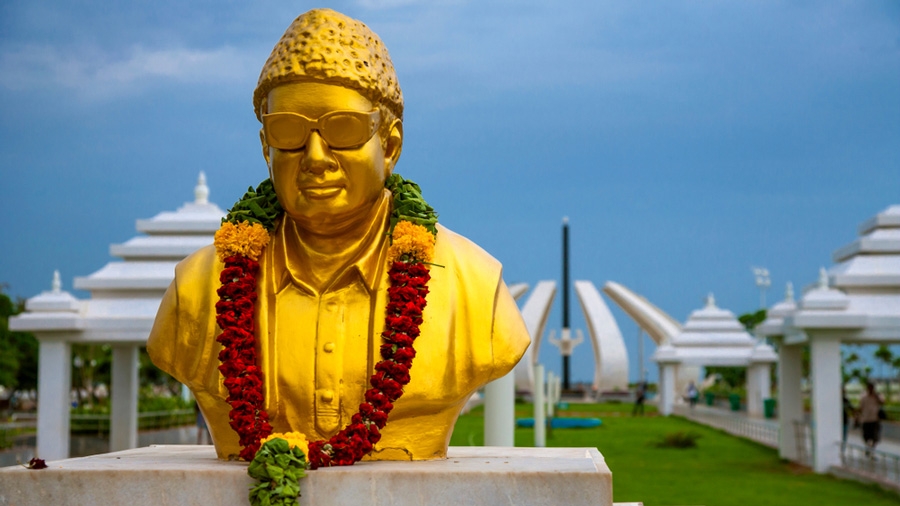Cries of “MGR Vazhga (Long live MGR)” and “Thalaiva, nee sollame poittaye (Oh Leader! You have gone without telling us)” rent the air as men and women wept and wailed and beat their chests as if one of their own had passed away. On Christmas eve in 1987, gloom descended over Madras and a sea of humanity gathered at the Marina to bid farewell to Marudur Gopalan Ramachandran aka MGR. The matinee-idol-turned politician, who strode over Tamil Nadu’s intertwined worlds of cinema and politics like a colossus, was interred dressed in his signature off-white synthetic vetti, full-sleeved shirt, dark shades and white fur-cap. On his right hand, as ever, was his Seiko watch. Decades after his interment, his admirers continue to flock to his grave. As they circumambulate the departed leader’s tomb, many press their ears to the granite slabs, hoping to hear MGR’s watch tick. The ritual followed by the believers of MGR, the founder of the All India Anna Dravida Munnetra Kazhagam — a party linked to the rationalist Dravidian movement — is symbolic of the uncanny sway that MGR wields over Tamil Nadu’s masses and political parties. Even 34 years after his death, it is not uncommon to see politicians cutting across party lines playing the ‘MGR’ card. Come elections and the Puratchi Thalaivar becomes larger than life as politicians promise to bring back the ‘golden MGR era’ and flaunt their proximity to the departed leader in a bid to stake claim to his legacy.
Over the years, different parties have tried to appropriate the charismatic leader’s legacy to gain political mileage. In 2005, after floating the Desiya Murpokku Dravida Kazhagam, the actor, Vijayakanth, had projected himself as ‘Karuppu MGR (Dark-skinned MGR)’. Rajinikanth and Kamal Haasan, too, have expressed their desire to revive MGR’s rule. But this election season, a new and unexpected entrant has joined the fray to stake claim to MGR and his legacy — the Bharatiya Janata Party.
Tamil Nadu has been a tough nut to crack for the BJP. The party’s biggest USP — the popularity of Narendra Modi — is inconsequential in the state. According to several surveys, Modi has a negative approval rating in Tamil Nadu. But the biggest hindrance to the saffron party’s efforts of gaining a toehold in the Dravidian heartland is that it is seen as an ‘outsider’ — an upper caste, north Indian party that endorses the Hindi-Hindu-Hindustan principle. The BJP has resorted to appropriating — misappropriating — local icons and invested heavily in the MGR card to make inroads in the state.
MGR’s phenomenal success as an actor and, later, as a politician and the emotions he continues to evoke among the people are nothing short of an enigma. His films projected him as the quintessential do-gooder. This carefully crafted image was manipulated to further his political ambitions. He also initiated Tamil Nadu’s culture of freebies — sewing machines and cycle rickshaws were distributed by his regime. But his master-stroke was extending the free mid-day meal scheme initiated by K. Kamaraj to cover over eight million schoolchildren.
MGR’s politics was based on pleasing anyone and everyone, including non-Dravidian voters. After Kamaraj’s death in 1975, the anti-DMK votes got transferred to the AIADMK, powering its maiden victory in the 1977 assembly elections. To retain the non-Dravidian vote, MGR whittled down the atheist-rationalist aspect of Dravidian politics. As chief minister, he frequently visited shrines. The anti-Brahmin plank of Periyar was also abandoned as two of MGR’s closest acolytes, J. Jayalalithaa and H.V Hande, were Brahmins. The MGR administration was also generous in doling out funds for temple renovation. While his predecessors had been vocal in demanding greater autonomy for the states, MGR distanced himself from an anti-Centre, regionalist stance as he realized that his government was dependent on the Centre for funding its welfare schemes.
MGR has emerged as a natural choice for the BJP, which is bereft of any local icons. The party hopes to make profitable political transactions by giving MGR’s legacy a pro-Hindu slant. The BJP realizes that it has little to gain in the 2021 polls but it hopes to dethrone the AIADMK and emerge as the principal opposition to the Dravida Munnetra Kazhagam in Tamil Nadu.
Only time will tell if the BJP would succeed in the long run by using the ‘MGR card’. But for now the party seems to be suffering from selective amnesia. MGR, the BJP’s new mascot, had called his ideology ‘annaism’, a heady mix of Dravidianism, Marxism and capitalism. Can the BJP be comfortable swallowing a dose of annaism?










